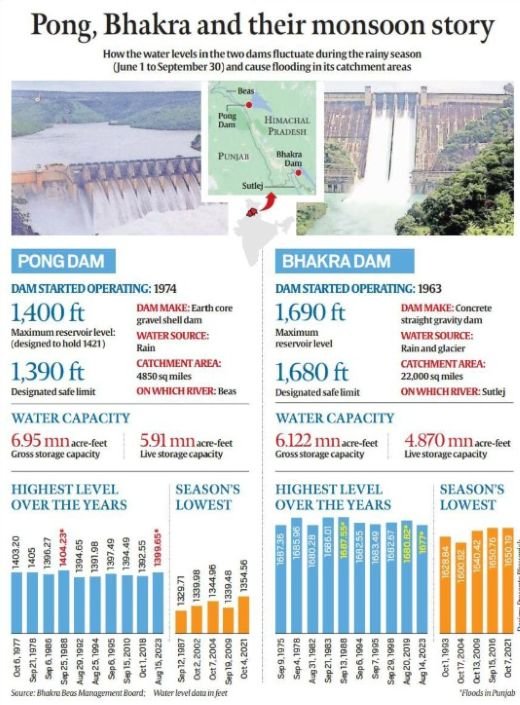
“Beyond the Dam: Water, Politics, and the Fractured Federalism of India”
- Breaking NewsHARYANAPUNJAB
- May 1, 2025
- No Comment
- 13
Water Wars: The Bhakra Beas Tensions Between Punjab and Haryana Escalate Again
Saptrishi Soni: In the simmering landscape of North India, where rivers have long served as lifelines and boundaries, a familiar battle has once again surfaced: water. This time, the flashpoint is the Bhakra Beas Management Board (BBMB) and its recent decision to release an additional 8,500 cusecs of water to Haryana, sparking fresh outrage in Punjab. The move, directed by India’s Union Ministry of Power, has intensified regional tensions and thrust a historic inter-state conflict back into national focus.
The BBMB meeting, which dragged on for over five hours this week, saw Punjab and Haryana locked in a fierce standoff. Despite vocal objections from Punjab and the absence of official consent, Haryana managed to secure a temporary victory as representatives from Rajasthan, Delhi, and the central government voted in favour of the release, citing humanitarian grounds. Himachal Pradesh, another stakeholder, chose to remain neutral. However, the issue remains far from resolved.
The Root of the Dispute: A History of Unequal Waters
The genesis of the Punjab-Haryana water dispute dates back to the early 1960s, following the bifurcation of Punjab and the subsequent creation of Haryana in 1966. The sharing of river waters—especially from the Ravi, Beas, and Sutlej—has been contested ever since. According to the 1976 order and subsequent agreements, Haryana was allocated 3.5 million acre-feet (MAF) of river water, while Punjab retained a lion’s share. Haryana has long contended that it has been receiving less than its fair share, and has on multiple occasions sought judicial and administrative redress.
Punjab, for its part, argues that it is already supplying over 4,000 cusecs of water to Haryana—more than double what Haryana requires for drinking water, which it estimates at 1,700 cusecs. Officials in Chandigarh warn that any further diversion will jeopardize agricultural operations, particularly in southern Punjab where cotton sowing is underway and water scarcity is becoming increasingly acute.
The present standoff is further complicated by BBMB’s internal regulatory guidelines. As per its own manual, any release of water must be formally requisitioned through an official “indent” from the home state. Punjab has refused to issue this indent, yet BBMB argues that extraordinary circumstances allow it to bypass this protocol. The Punjab contingent walked out in protest and declined to sign the final proceedings of the meeting.
Why It Matters: Stakes Beyond Water
For Punjab, the implications are both agrarian and political. Agriculture forms the backbone of the state’s economy, and water from Bhakra Dam is vital during the sowing season. With water levels already receding, the fear is that any additional outflow will hamper irrigation and affect crop yields. Politically, Chief Minister Bhagwant Mann has taken a strong stand, rejecting the BBMB’s decision outright, which is likely to find support among a populace historically sensitive to water rights.
In Haryana, the stakes are equally significant. The state, particularly in southern and western regions, has long struggled with groundwater depletion and erratic monsoons. The additional water is meant to alleviate a growing drinking water crisis, although Punjab argues that the increase from 4,000 to 8,500 cusecs is excessive and suggests that Haryana’s intent is agricultural rather than humanitarian. Indeed, Punjab’s officials pointed out that Haryana has already utilized 3.110 MAF of its allotted 2.987 MAF—more than 104% of its share.
At the heart of the disagreement lies a conflict between legal entitlement and perceived equity. While Haryana appeals to constitutional fairness and national humanitarian standards, Punjab stands on procedural sanctity and the pressing demands of its own people.
Centre in the Crossfire
The Union government’s apparent tilt towards Haryana has not gone unnoticed. The Central Electricity Ministry’s directive to reconvene the BBMB meeting under pressure has added fuel to the fire, with Punjab accusing New Delhi of favouritism. The delicate federal balance of India’s political system is being tested once again, as regional leaders grapple with decisions made in the capital.
This isn’t the first time the Centre has been caught in such a storm. In 2004, Punjab passed the Punjab Termination of Agreements Act to annul all water-sharing agreements, including with Haryana—a move that was later stayed by the Supreme Court. Legal ambiguities and political posturing have kept the issue unresolved for decades, with the Sutlej-Yamuna Link (SYL) canal being another major flashpoint.
An Uncertain Path Ahead
The BBMB’s decision might offer temporary relief to Haryana, but without a mutually agreed framework and legal clarity, the underlying friction is bound to resurface. There have been calls to revisit the BBMB regulatory manual, or even set up an independent tribunal to reallocate water based on updated demographic and environmental data. Until then, each emergency meeting will remain a flashpoint, not a solution.
As climate change increasingly threatens India’s river systems, disputes like this will only become more frequent and more volatile. A long-term vision, not short-term politics, is what’s needed. Water, after all, is too precious a resource to be dictated by deadlocks and directives.
This article is auto-generated and editorially reviewed for digital publication.
#WaterCrisis #PunjabHaryanaDispute #BhakraDam #IndiaPolitics #ClimateJustice



